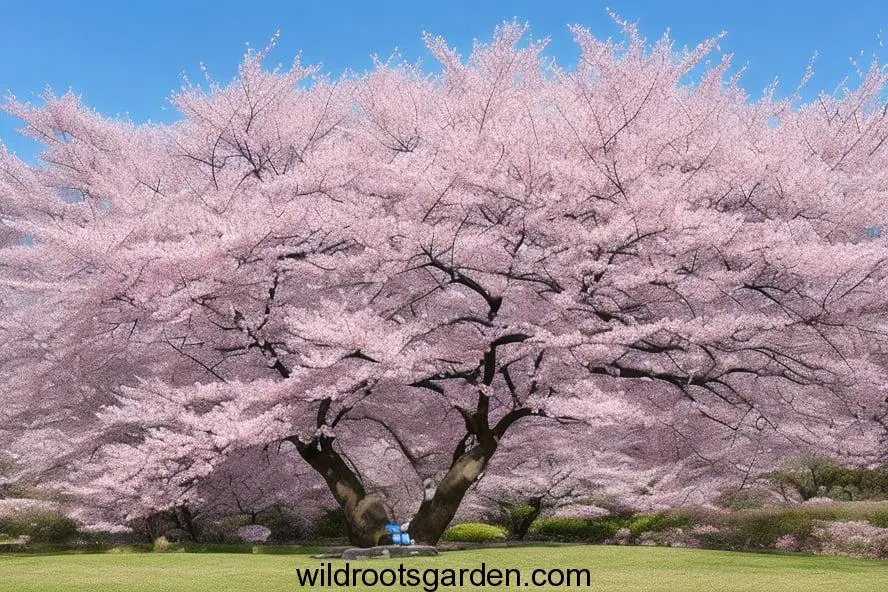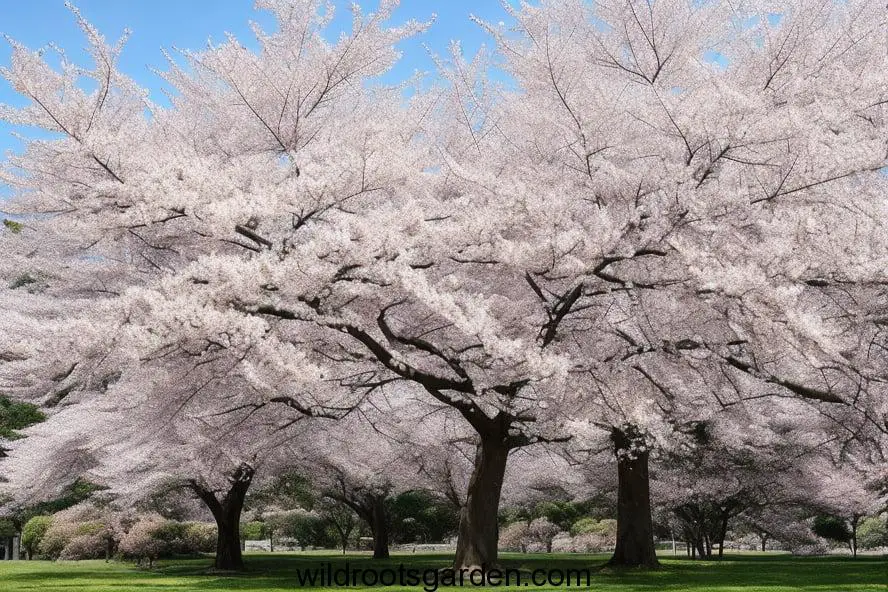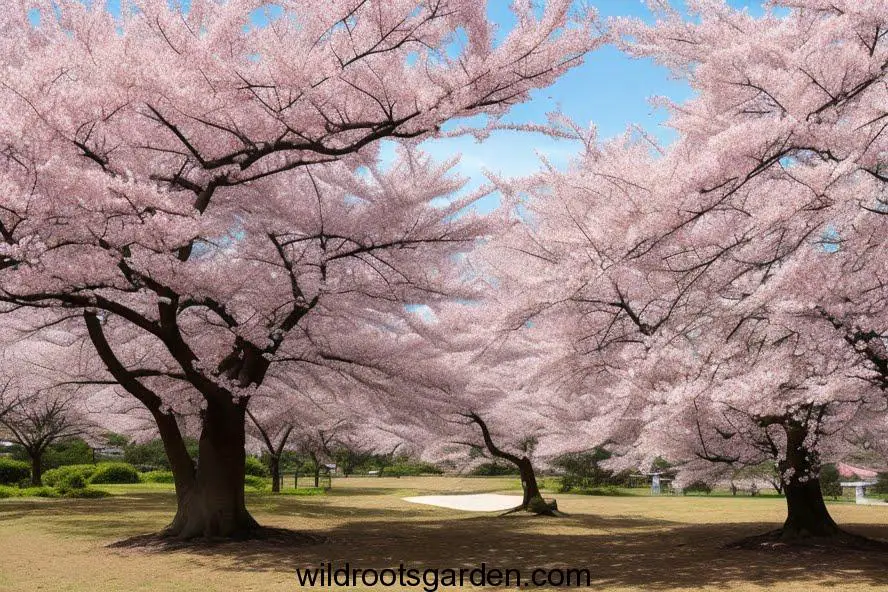Akebono Cherry Tree vs Yoshino Cherry Tree. Cherry trees are celebrated for their exquisite beauty and enchanting blossoms, which captivate people around the world. Among the various cherry tree varieties, Akebono and Yoshino stand out for their breathtaking displays of delicate flowers. Both originating from Japan, these two species have unique characteristics that make them sought-after favorites in gardens and parks. In this comparison, we will explore the distinctions between the Akebono Cherry Tree and the Yoshino Cherry Tree, shedding light on their appearance, blooming patterns, growth habits, and cultural significance. By delving into the attributes of these two majestic cherry trees, we aim to provide a comprehensive understanding of their individual charm and allure, helping enthusiasts and horticulturists make informed decisions when choosing between these captivating varieties for their landscapes.
Akebono Cherry Tree

Description
The magnificent flowering tree Prunus x yedoensis ‘Akebono,’ often known as the Akebono cherry tree, is a member of the Rosaceae family. It is well known for the stunning pink blossoms that cover the tree each spring and produce an eye-catching display of color.
Origin and History
The Akebono cherry tree is a native of Japan, and it was given that name in honor of Tokyo’s Akebono-no-mizu spring. As a result of its decorative value and graceful presence, it has grown in popularity since it was first brought to the United States in the early 1900s.
Characteristics and Benefits
The deciduous Akebono cherry tree normally grows to a height of 25 to 35 feet (7.6 to 10.7 meters). Its branches extend widely, giving it a graceful and lovely shape. The tree adds a touch of nature to your landscape by producing clusters of double-petaled pink flowers that draw bees and butterflies.
A popular option for residential settings, the Akebono cherry tree gives shade during the hot summer months in addition to its visual appeal. Its colorful fall foliage, which ranges from yellow to bronze, lends still another level of appeal to the landscape.
Growing and Maintenance Tips
To ensure the healthy growth of your Akebono cherry tree, follow these tips:
Planting: Choose a location with well-draining soil and full sun exposure. Dig a hole that is slightly wider and deeper than the root ball, and backfill it with a mixture of soil and organic matter.
Watering: Keep the tree well-watered, especially during the first year after planting. Provide deep watering sessions rather than frequent shallow watering.
Pruning: Prune your Akebono cherry tree during the dormant season to remove dead or diseased branches and promote healthy growth.
Fertilizing: Apply a balanced fertilizer in early spring to provide essential nutrients to the tree.
Now, let’s explore the Yoshino cherry tree and see how it compares to the Akebono variety.
Yoshino Cherry Tree

Description
The Yoshino cherry tree, Prunus x yedoensis ‘Yoshino,’ is a lovely flowering tree with a significant cultural and historical background. At cherry blossom festivals, its beautiful, pale pink blooms are often praised as a sign of the coming of spring.
Origin and History
The Yoshino cherry tree was first cultivated in Japan, where it bears the name of the Yoshino hamlet in Nara Prefecture. One of the most well-liked cherry tree kinds, it was brought to the United States in the early 1900s.
Characteristics and Benefits
A deciduous tree, the Yoshino cherry tree normally grows to a height of 30 to 40 feet (9 to 12 meters). The beautiful, horizontal pattern of its branches creates an appealing shape. The tree bears pale pink flowers with one, five, or occasionally six petals that when fully bloomed, form a captivating display.
The Yoshino cherry tree has more advantages than just its lovely beauty, like luring pollinators and offering shade. In the fall, its leaves changes to vivid hues of yellow and bronze, bringing a touch of autumnal splendor to your yard.
Growing and Maintenance Tips
To ensure the healthy growth of your Yoshino cherry tree, consider the following tips:
Site Selection: Choose a location with well-drained soil and full sun exposure for optimal growth and blooming.
Soil Preparation: Prior to planting, amend the soil with organic matter to improve its fertility and drainage.
Watering: Provide regular watering, especially during dry periods, to keep the tree adequately hydrated.
Pruning: Prune your Yoshino cherry tree during the dormant season to remove dead or crossing branches and maintain its shape.
Now that we have explored the characteristics of both the Akebono and Yoshino cherry trees, let’s compare them to help you decide which one suits your preferences and garden requirements.
Akebono vs. Yoshino: Comparison
Appearance and Blooming Time
Beautiful pink blossoms are produced by both Akebono and Yoshino cherry trees, albeit there are minor variations in appearance and flowering time. The blooms of the Akebono cherry tree have two petals, giving them a fuller appearance. Early April is when it normally blossoms, usually before the Yoshino cherry tree.
The Yoshino cherry tree, on the other hand, has single-petaled or sometimes multi-petaled blossoms. It usually blooms in the middle to end of spring, frequently during festivals honoring cherry blossoms. The single-petalled blossoms have a refined and delicate appearance.
Hardiness and Adaptability
When it comes to hardiness and adaptability, both cherry tree varieties thrive in USDA hardiness zones 5 to 8. However, the Yoshino cherry tree is considered slightly more adaptable and tolerant of various soil conditions compared to the Akebono cherry tree.
Disease Resistance
The Yoshino cherry tree has demonstrated greater disease resistance to typical cherry tree diseases including cherry leaf spot and powdery mildew. Although the Akebono cherry tree is normally in good health, further maintenance and disease prevention measures could be necessary.
Cultural Significance
Both the Akebono and Yoshino cherry trees are revered in Japan and other countries for their cultural significance. They are honored during cherry blossom festivals and serve as a metaphor for the fleeting beauty of life and the coming of spring. Particularly the Yoshino cherry tree has come to represent the traditional cherry blooms of Japan.
Which Cherry Tree to Choose?
The choice between the Akebono and Yoshino cherry trees ultimately comes down to your environment, preferences, and landscaping.
Climate and Location Considerations
Consider the specific climate and location where you intend to plant the cherry tree. If you live in a region with harsh winters, it is important to choose a variety that is hardy and can withstand colder temperatures. Both the Akebono and Yoshino cherry trees are suitable for USDA hardiness zones 5 to 8.
Personal Preferences
Consider your particular preferences for the cherry tree’s beauty and blooming season. The Akebono cherry tree can be a better option if you like a tree with fuller, double-petaled blossoms and an early blooming time. The Yoshino cherry tree, on the other hand, can be more tempting if you want delicate, single-petaled blooms and a slightly later blooming time.
Landscape Design and Aesthetic
Think about the overall look and design of the landscape you want to achieve. Both cherry tree varieties may enhance the beauty and appeal of any garden with their beautiful silhouettes and spreading branches. Consider the area that is available and how each tree might enhance the other features of your landscaping.
In conclusion, both the Akebono Cherry Tree and the Yoshino Cherry Tree hold a special place in the hearts of cherry blossom admirers worldwide. While they share a common origin in Japan, each tree offers a distinct and captivating experience when it comes to its appearance, blooming patterns, and growth habits.
The Akebono Cherry Tree enchants with its vibrant and exuberant pink blossoms, creating a lively and colorful atmosphere in gardens and parks. Its ability to bloom multiple times throughout the season adds an element of surprise and extended enjoyment for enthusiasts.
On the other hand, the Yoshino Cherry Tree is renowned for its ethereal and delicate white blossoms, blanketing the landscape in a breathtaking snowy wonderland during spring. Its grand, majestic form and simultaneous flowering showcase an awe-inspiring spectacle.
Ultimately, the choice between the Akebono and Yoshino Cherry Trees boils down to personal preferences, garden space, and desired visual impact. Whichever variety you choose, the beauty and splendor of these cherry blossoms will undoubtedly leave an indelible mark, evoking a sense of joy, serenity, and appreciation for the wonders of nature.
FAQs
Are Akebono and Yoshino cherry trees the same?
No, they are different varieties of cherry trees with slight differences in appearance and blooming time.
Can Akebono and Yoshino cherry trees grow in the same climate?
Yes, both varieties thrive in USDA hardiness zones 5 to 8.
How long does it take for Akebono and Yoshino cherry trees to bloom?
Akebono cherry trees usually bloom in early spring, while Yoshino cherry trees bloom in mid to late spring.
Are Akebono and Yoshino cherry trees prone to diseases?
While both varieties are generally healthy, the Yoshino cherry tree has shown more resistance to common cherry tree diseases.
What is the best time to plant Akebono and Yoshino cherry trees?
It is recommended to plant cherry trees during the dormant season, typically in late fall or early spring.

